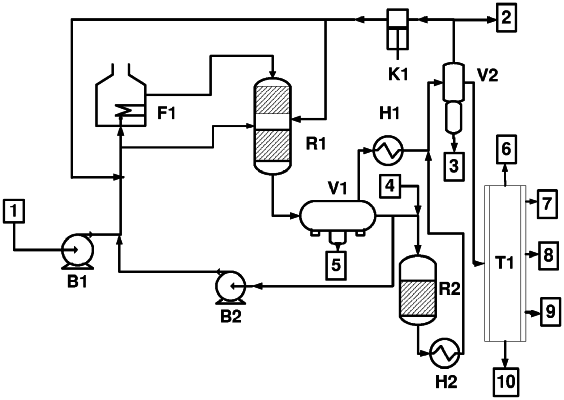| CPC C10G 3/46 (2013.01) [B01J 21/04 (2013.01); B01J 21/066 (2013.01); B01J 23/30 (2013.01); B01J 23/85 (2013.01); B01J 29/06 (2013.01); B01J 37/0201 (2013.01); C10G 3/50 (2013.01); C10G 47/10 (2013.01); B01J 2229/26 (2013.01); C10G 2300/1003 (2013.01); C10G 2300/1011 (2013.01); C10G 2400/02 (2013.01); C10G 2400/04 (2013.01)] | 18 Claims |

|
1. A method to produce renewable fuels and paraffinic distillates, the method comprising:
receiving a renewable selected from plant oils, animal fats, residual edible oils or acids;
receiving a process load comprising a mixture of a renewable stream, in the range of 1 to 75% by weight, and a fossil hydrocarbon stream, in the range of 99 to 25% by weight;
receiving a composite load stream diluted with a recycle of a liquid stream from a first separator vessel so that a volumetric dilution ratio is 2 to 10 diluent/load; and
performing a hydroconversion of the composite load stream is carried out in one or more reactors, in a presence of hydrogen, without injection of a sulfidizing agent, wherein the hydroconversion is carried out in two stages, hydrodeoxygenation/polymerization and hydrocracking, and in a presence of two distinct types of catalysts, Type 1 and Type 2, partially reduced,
wherein the Type 1 catalyst is used within the hydrodeoxygenation/polymerization stage, the Type 1 catalyst comprising metal oxides of the VIB group, partially reduced in a hydrogen atmosphere, and supported on materials with a sufficiently high specific area and a sufficiently low acidity for the hydrodeoxygenation/polymerization stage to function,
wherein an operating condition of the hydrodeoxygenation/polymerization stage being: pressure from 4 to 10 MPa, average catalytic bed temperatures between 320 and 400° C., space velocity between 0.5 to 2 h−1 and a H2:load ratio from 200 to 1000 NL of H2/liter of load of the composite load stream,
wherein the Type 2 catalyst is used within the hydrocracking stage, the Type 2 catalyst comprising metal oxides from the VIB group and from the VIIIB group, partially reduced, and supported on materials with a sufficiently high specific area of a sufficiently high acidity for the hydrocracking stage to function, and
wherein an operating condition of the hydrocracking stage being: pressure from 4 to 10 MPa, average catalyst bed temperatures between 320 and 400° C., space velocity between 0.5 to 2 h−1 and H2:load ratio from 200 to 1000 NL of H2/liter of load of the composite load stream.
|